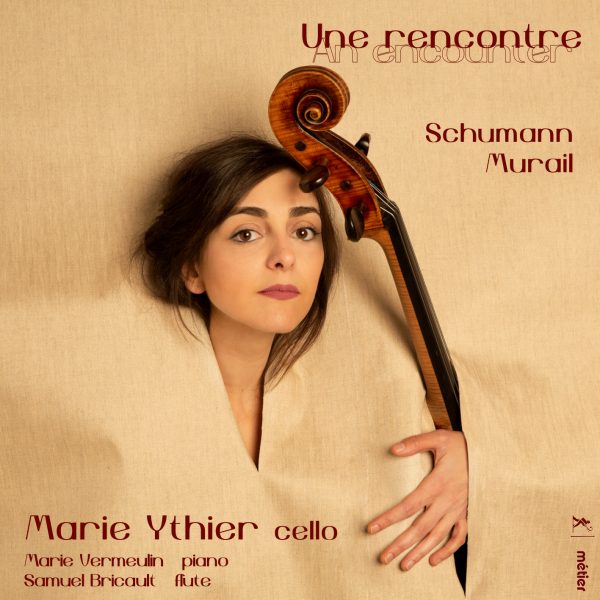ResMusica
Nothing in advance foreshadowed the “encounter” between Tristan Murail, a composer of the spectral movement belonging to a French line of timbre and harmony, and Robert Schumann, the singer of German polyphony. This was the idea of the cellist Marie Ythier and the challenge it raises is explored in this new album where she is accompanied by the pianist Marie Vermeulin and the flutist Samuel Bricault.
It is by “rereading” his Schumann with a more attentive ear, writes Tristan Murail in the CD booklet notes, that he comes to recognize an analogy between the “mood” music of German Romanticism and his own way of composing: What is really important, in all musical discourse, irrespective of the style or historical context, is the interplay between the predictable and the unpredictable, between continuity and discontinuity, between what is new and what is recalled”.
And to seal this unexpected ‘meeting’, the idea came to him to appropriate one of the pieces for piano Schumann, in this case the very famous Kinderszenen and to propose a “mise en colors” for flute, cello and piano, bringing together, at the end of the recording, the three instrumentalists of the album. While the basic score is respected to the letter, the theatrical space is amplified, by the relaying of instrumental timbres that animate the polyphony, by the extended playing techniques that revitalize the writing (slips and sul ponticello of the cello, breath, bisbigliando and flatterzunge of the flute, piano-harp, etc.) and the choice of the registers which underlines the perspectives such as these cello harmonic rockets in Am Camin (“By the fire”) and these energetic projections of the breath and other percussive modes of play in Ritter vom Steckenpferd (“Rider on the Wooden Horse”). The alto flute is summoned in Kind im Einschlummern (“the child goes to sleep”), one of the most beautiful Schumannian pages to which Murail brings his singular touch, as sensitive as it is emotional.
The same energy underlies the performance of Marie Ythier and Marie Vermeulin in Robert Schumann’s Fünf Stücke im Volkston (Five Pieces in a Popular Tone), which start off this album under the best auspices. Between fiery élan and expressive effusions, the expansive lines and the warm tone of Marie Ythier’s cello delight us. It is supported by the piano of Marie Vermeulin, very close in the recording, which admirably serves the always clear polyphony of the composer, as it is expressed in the third movement, Nicht schnell, with viel Ton zu spielen (retained and intense), one of the summits of the cycle magnified further by our two performers. Even more famous and no less endearing, the Fantasiestücke, op.73, composed the same year, approached the atmosphere of the Lied in the first movement, Zart und mit Ausdruck, played in total unity by the two musicians. It is Marie Vermeulin’s colorful piano that leads the second movement, tackled in a sense of urgency and emotional sensitivity. Enthusiasm and a touch of Schumannian madness cross the last movement under the angry bow of Marie Ythier, without however destabilizing the beautiful rhythmic rhythm of the piano, within a very removed musical discourse.
A surprise comes with the inaugural figure, close to electronic sound, of Strange Attractors (1992), a spectral play of scale written for cello alone by Tristan Murail, who finds his place between the two duets of Schumann. Marie Ythier displays powerful gestures and an impressive palette of colors in a moving space where matter is in perpetual transformation. Shorter but equally adventurous, the second solo cello work from the album borrows its long title from the Song of Songs: It’s a secret garden, my fiancée, a fountain, a sealed source … (1976). This work was written originally for the viola, on the occasion of the marriage of two friends. Tristan Murail explores, through extensive playing techniques, the fragile and luminous universe of the instrument’s harmonics. Marie Ythier details very finely all components, in an intimate register and a sensuality that shines. More than forty years of creation separate this juvenile score from Vincent’s Letter written in 2018 for cello and flute. A touch of nostalgia pervades the writing of this duet, where the composer reinstates a melodic dimension. Murail remembers a childhood memory, a book on Van Gogh that had been offered to him, with the paintings of the painter and the letters written to his brother, all beginning with “My dear Theo”. The formula becomes musical: four notes and two intervals evoking the master Messiaen, when the solo flute and its flatterzunge, on the pizzicati of the cello, recall the beginning of Mémoire de Boulez.
But everything combines, transforms and merges, over a labyrinthine trajectory where the four notes serve as breadcrumbs. Marie Ythier and Samuel Bricault surround the acoustic world with a lot of fluidity and a racy sound.
@divineartrecordingsgroup
A First Inversion Company
Registered Office:
176-178 Pontefract Road, Cudworth, Barnsley S72 8BE
+44 1226 596703
Fort Worth, TX 76110
+1.682.233.4978












